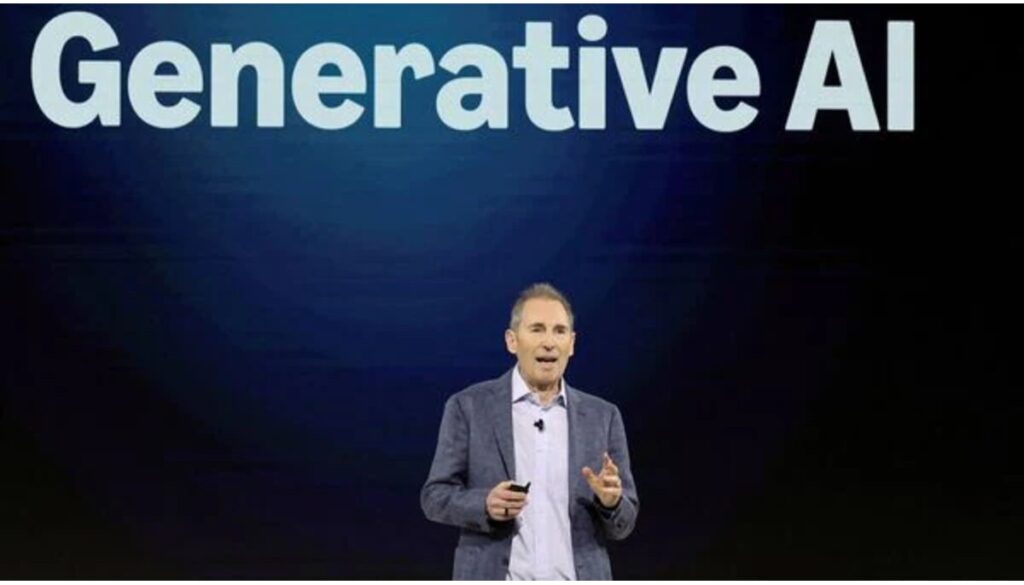Amazon’s CEO Andy Jassy has confirmed that corporate job cuts are no longer temporary cost reductions—they’re part of a structural shift fueled by generative AI transformation. In his recent annual shareholder letter and internal memo, Jassy announced that as Amazon leans into AI-first operations, roles across corporate functions will be systematically reduced over the next few years (businessinsider.com, theverge.com).
1. The AI‑First Enterprise: Why Workforce Reductions Are Strategic
A Shift in Messaging
- Unlike past layoffs blamed on post‑pandemic budget misalignment, this time Amazon is transparent: AI is intentionally replacing human roles .
- Jassy: “We will need fewer people doing some of the jobs… efficiency gains from using AI extensively across the company.” .
Scale of Reductions
- Since late 2022, Amazon has cut over 27,000 roles, including 14,000 managerial jobs in early 2025—about 13% of global corporate leadership, saving up to $3.6 billion annually (reddit.com).
Business Context
- Although revenue remains strong, Amazon’s revenue per employee lags behind peers like Microsoft and Apple—cutting staff is a way to close that gap (wsj.com).
2. AI Tools Replacing Corporate Functions
Amazon has launched over 1,000 AI-powered tools internally, reshaping functions across the board (wsj.com):
- Alexa+: autonomous voice assistant with decision-making capabilities.
- Global AI shopping assistant: supports tens of millions of customers.
- Purchase automation: Lens, Buy for Me, Recommended Size.
- Seller tools: auto-generate listings, creative campaign content.
- AWS bots: Q and QCLI draft and debug code.
- Warehouse AI: improved inventory forecasting, robot pathing, delivery speeds.
“Agents will let you tell them what you want… scour the web, write code… automate a lot of tasks that consume our time,” stressed Jassy (retaildive.com, timesofindia.indiatimes.com, theverge.com).
These automation efforts aren’t superficial—they’re designed to reduce roles in areas like customer service, corporate communications, HR, and content development.
3. The Broader Tech Layoff Trend

Amazon’s approach mirrors a wider industry trend: as of mid‑2025, over 61,000 jobs have been cut by more than 130 tech companies (barrons.com, reuters.com).
- Microsoft: cutting thousands in sales teams alongside an $80 billion investment in AI infrastructure (reuters.com).
- Meta, Google, IBM, CrowdStrike: adjusting hiring plans in line with AI strategies (barrons.com).
CEOs across the board are framing AI as both a growth enabler and a workforce reducer .
4. Internal Response: Upskilling Over Replacement
Despite the layoffs, Amazon emphasizes upskilling employees to work alongside AI:
- Jassy encouraged employees to become familiar with AI tools to remain productive (businessinsider.com, wsj.com).
- A former developer noted his comfort with AI-augmented workflows augmented engineer work, not replaced it (businessinsider.com).
- Jassy’s messaging echoes calls from tech leaders who urge adoption or risk obsolescence (businessinsider.com).
However, some internal unrest has emerged—former employees argue that the company is viewing workers as “costs to cut” rather than innovation drivers.
5. Strategic Motives Behind AI Investment

AI = Once‑in‑a‑Generation
Jassy equated generative AI to the rise of the internet or cloud (theverge.com, retaildive.com).
Amazon projects to invest $75–100 billion in AI and cloud infrastructure in 2025 (en.wikipedia.org).
AWS as AI Backbone
Amazon views AWS as the core platform for generative AI—supporting internal tools, enterprise clients, and foundational models .
Efficiency & Innovation Gains
AI automation brings significant efficiency—like Amazon Q saving 4,500 developer-years and $260 million annually (timesofindia.indiatimes.com).
Jassy highlights efficiency and delivery speed improvements via AI and regionalized logistics (investopedia.com).
6. Risks & Consequences

1. Workforce Anxiety & Burnout
Flattened management structures and expanded workloads are leading to employee burnout and insecurity (wsj.com).
2. Skill Mismatch & Job Displacement
Roles with less direct customer or creative impact face greater elimination; ongoing training and transition support remains crucial .
3. Organizational Culture
The shift toward an “AI-first”, startup-like culture has mixed reception—bureaucracy is being slashed, but some worry about loss of institutional knowledge .
7. What It Means for Amazon Employees
| Employee Category | What It Means | Recommendation |
|---|---|---|
| Managers | High likelihood of role elimination | Upskill in AI management and strategic roles |
| Engineers/Developers | AI augments rather than replaces roles | Learn AI tooling like QCLI, Bedrock |
| Corporate Staff (Marketing, HR, Comms) | AI taking over routine tasks | Re-skill in AI oversight, analytics |
| Warehouse/Delivery | Efficiency gains may reduce need for manual labor | Explore tech-training for supply chain AI |
Amazon offers support via separation packages, re-skilling, and job placement services.
8. Looking Ahead: AI & Workforce in 2025
- Job cuts will continue via attrition or targeted layoffs focused on automation-led efficiency (businessinsider.com, peoplematters.in, wsj.com).
- New AI-focused roles will emerge—roles will transform rather than disappear.
- Cross-industry normalization: AI-driven workforce changes will become a competitive necessity across tech and beyond .
Amazon Job Cuts – Key Figures (2022–2025)

| Year | Job Cuts Announced | Departments Affected | Notes |
|---|---|---|---|
| Late 2022 | 27,000+ | Corporate, Tech, Alexa, Kindle | Initial wave post-pandemic |
| Early 2025 | 14,000+ | Mid-level Management, HR, Prime Video, Twitch | 13% of global corporate staff |
| Total | 41,000+ | Multiple | $3.6 billion in projected savings |
AI Tools Replacing Traditional Roles at Amazon
| AI Tool/Platform | Purpose | Replaces/Reduces |
|---|---|---|
| Alexa+ | Smarter voice assistant with action-taking ability | Customer service, manual assistance |
| AI Shopping Assistant | Personalized shopping & automation | Front-end support, recommendation teams |
| Lens / Buy for Me | Visual and automated buying tools | Product research, personal shopping |
| Q / QCLI (AWS) | AI dev tools that write/debug code | Developer assistant tasks |
| Campaign Generators | Seller content automation | Marketing & content writing roles |
| Warehouse AI | Optimized delivery, robot routing | Supply chain and logistics analysts |
Strategic Goals Behind Amazon’s AI Investment

| Strategic Area | Impact of AI Integration | Keywords |
|---|---|---|
| Cost Efficiency | Reduction in overhead and operational expense | AI efficiency gains, cost cutting |
| Innovation Speed | Faster product rollout and decision-making | AI for automation, agile deployment |
| Customer Experience | Hyper-personalized recommendations and actions | AI-powered personalization |
| Developer Productivity | AI agents assist with coding, debugging, testing | AI tools for developers |
| Logistics Optimization | Inventory and delivery streamlined via AI | Supply chain automation |
Comparison – Past vs Present Layoff Rationale
| Timeframe | Primary Reason | Description |
|---|---|---|
| 2022–2023 | Cost Optimization | Post-COVID hiring corrections |
| 2024 | Restructuring + Cost Cuts | Middle management downsizing |
| 2025 (Current) | AI-led Workforce Reduction | Automation is replacing corporate roles |
Roles Most at Risk Due to AI Automation
| Job Role/Function | Risk Level | AI Impact Description |
|---|---|---|
| Middle Management | High | Decision layers flattened by AI agents |
| HR & Recruiting Ops | Medium | AI handling shortlisting, onboarding, assessments |
| Marketing Content Writers | High | AI generating product descriptions & campaigns |
| Customer Service | High | Alexa+ and AI chatbots replacing manual support |
| Logistics Planners | Moderate | AI forecasting and real-time routing |
| Software Testers | Low | AI supports but doesn’t replace coding insight |
Tech Sector Job Cuts 2025 – Company-wise Breakdown
| Company | Approx. Layoffs (2025) | AI Integration Focus Area |
|---|---|---|
| Amazon | 14,000 (2025 alone) | Alexa, AWS, Fulfillment, DevOps |
| Microsoft | ~6,000 | Copilot, Azure OpenAI |
| Meta (Facebook) | ~3,000+ | LLaMA models, internal AI agents |
| ~4,000 | Gemini AI, cloud, search intelligence | |
| IBM | ~2,000 | Watson AI, enterprise automation |
Long-Tail SEO Keywords Used in Content
| Long-Tail Keyword | Intent Type | Placement Priority |
|---|---|---|
| Amazon job cuts AI transformation 2025 | Informational | High |
| Andy Jassy memo generative AI layoffs | Navigational | High |
| Amazon corporate workforce reduction AI strategy | Informational | Medium |
| AI replacing corporate roles at Amazon | Informational | High |
| AWS Q AI tools for developers | Transactional | Medium |
| Amazon employee layoff strategy with AI | Informational | High |
Conclusion
Amazon’s headcount reductions are not a reflex—they’re a deliberate pivot to an AI-first future, with roles reshaped or eliminated in favor of automation. As the company invests heavily in AI, employees are urged to reskill, adapt, and embrace AI collaboration to remain integral to the firm’s operations. This shift encapsulates a broader transformation in the tech industry: AI is not a temporary cost‑cutting measure; it’s strategically redefining workforce norms across corporate functions.

